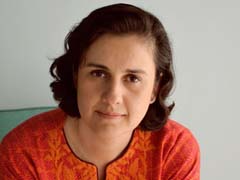Kamila Shamsie spoke about the past and present of Karachi, the city of her birth. She described how the once-open city has become a place in which almost all possibilities are closed.
The Pakistani writer Kamila Shamsie spoke at the CCCB on 24 March when she gave the last lecture in the Open City cycle, which began on 27 January. Her lecture, titled “The Unmapped City”, was presented by the writer Najat el Hachmi. Now residing in London, Shamsie spoke of her birthplace Karachi, a city that just over fifty years ago was open to all kinds of possibilities but that is now plagued by “ethnic, sectarian and class divisions”. She began her lecture by stating that she has “never seen a map of Karachi”, thus characterising a place in which the physical signs of a truly collective coexistence are absent, a highly fragmented place with lives that are “very disconnected”. In today’s Karachi, violence and tensions among its inhabitants are evermore palpable, while democracy has been supplanted by political clientelism geared to furthering the interests of different religious groups. Shamsie asked how the open city, which Karachi must have been at the end of the 1940s, came to this. In seeking answers, she necessarily had to turn to history, the history of the transformation of the city since it was first founded. At the time and despite all the traumas of partition, its population then saw it as an “open city”. She described how Karachi’s physical evolution has powerfully influenced its political transformation, with urban planning by a government that spoke of democracy as a “destiny” rather than as a path on which it had already set out, thereby laying the groundwork for the urban planning structure that has made possible today’s political and social fragmentation and physical deterioration. As she had done at the start of her lecture, Shamsie went on to speak of Karachi’s inhabitants, praising their ability to overcome the lack of references concerning their city, and describing how, through “shared knowledge”, they have achieved “shared experiences” and “psychological truths”, a way of orienting themselves and of guiding others. She concluded by linking the metaphor of the unmapped place with the political and social problems, asking why we need maps and suggesting that it is not so much because they tell us how to get from A to B, but rather that we can look at the map of a city and see that we are all united so that, for an instant, we can believe in a world without bullets, without divisions, without bloodstains but simply one with “streets that lead to other streets” and that “make all kinds of connection possible”.



